engine coolant PONTIAC G6 2010 User Guide
[x] Cancel search | Manufacturer: PONTIAC, Model Year: 2010, Model line: G6, Model: PONTIAC G6 2010Pages: 448, PDF Size: 2.5 MB
Page 285 of 448
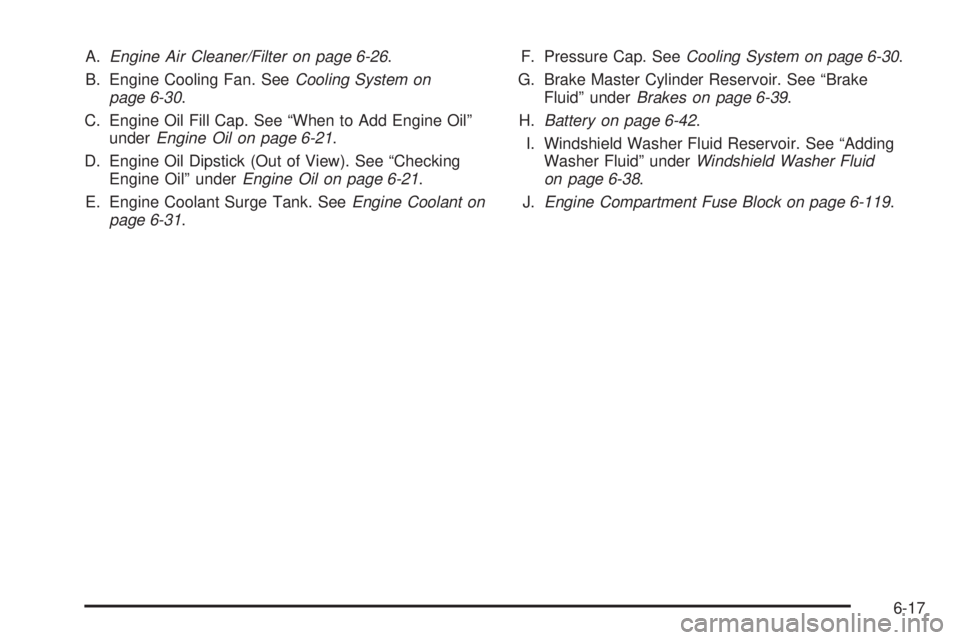
A.Engine Air Cleaner/Filter on page 6-26.
B. Engine Cooling Fan. SeeCooling System on
page 6-30.
C. Engine Oil Fill Cap. See “When to Add Engine Oil”
underEngine Oil on page 6-21.
D. Engine Oil Dipstick (Out of View). See “Checking
Engine Oil” underEngine Oil on page 6-21.
E. Engine Coolant Surge Tank. SeeEngine Coolant on
page 6-31.F. Pressure Cap. SeeCooling System on page 6-30.
G. Brake Master Cylinder Reservoir. See “Brake
Fluid” underBrakes on page 6-39.
H.Battery on page 6-42.
I. Windshield Washer Fluid Reservoir. See “Adding
Washer Fluid” underWindshield Washer Fluid
on page 6-38.
J.Engine Compartment Fuse Block on page 6-119.
6-17
Page 287 of 448
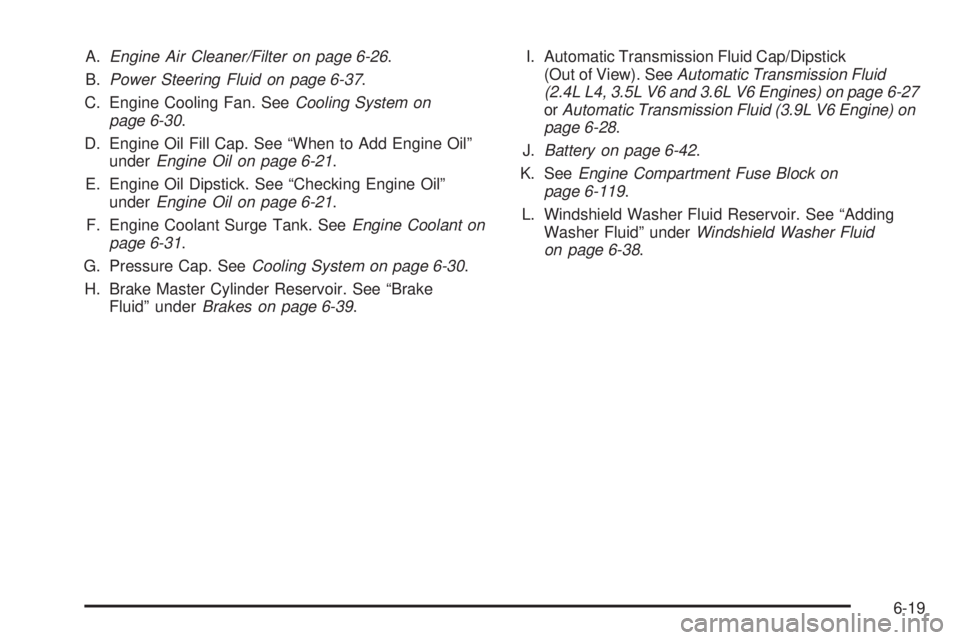
A.Engine Air Cleaner/Filter on page 6-26.
B.Power Steering Fluid on page 6-37.
C. Engine Cooling Fan. SeeCooling System on
page 6-30.
D. Engine Oil Fill Cap. See “When to Add Engine Oil”
underEngine Oil on page 6-21.
E. Engine Oil Dipstick. See “Checking Engine Oil”
underEngine Oil on page 6-21.
F. Engine Coolant Surge Tank. SeeEngine Coolant on
page 6-31.
G. Pressure Cap. SeeCooling System on page 6-30.
H. Brake Master Cylinder Reservoir. See “Brake
Fluid” underBrakes on page 6-39.I. Automatic Transmission Fluid Cap/Dipstick
(Out of View). SeeAutomatic Transmission Fluid
(2.4L L4, 3.5L V6 and 3.6L V6 Engines) on page 6-27
orAutomatic Transmission Fluid (3.9L V6 Engine) on
page 6-28.
J.Battery on page 6-42.
K. SeeEngine Compartment Fuse Block on
page 6-119.
L. Windshield Washer Fluid Reservoir. See “Adding
Washer Fluid” underWindshield Washer Fluid
on page 6-38.
6-19
Page 289 of 448
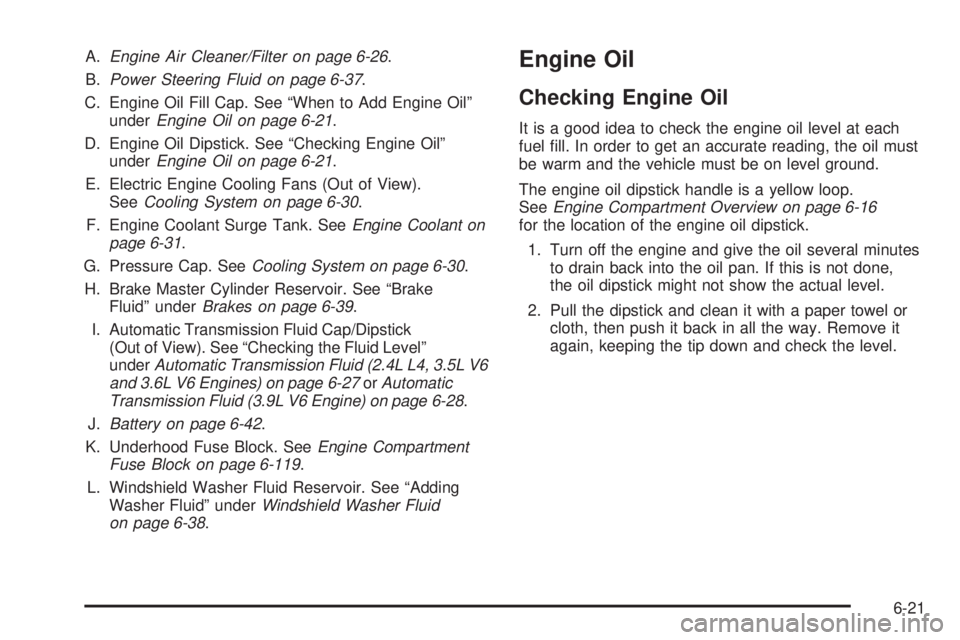
A.Engine Air Cleaner/Filter on page 6-26.
B.Power Steering Fluid on page 6-37.
C. Engine Oil Fill Cap. See “When to Add Engine Oil”
underEngine Oil on page 6-21.
D. Engine Oil Dipstick. See “Checking Engine Oil”
underEngine Oil on page 6-21.
E. Electric Engine Cooling Fans (Out of View).
SeeCooling System on page 6-30.
F. Engine Coolant Surge Tank. SeeEngine Coolant on
page 6-31.
G. Pressure Cap. SeeCooling System on page 6-30.
H. Brake Master Cylinder Reservoir. See “Brake
Fluid” underBrakes on page 6-39.
I. Automatic Transmission Fluid Cap/Dipstick
(Out of View). See “Checking the Fluid Level”
underAutomatic Transmission Fluid (2.4L L4, 3.5L V6
and 3.6L V6 Engines) on page 6-27orAutomatic
Transmission Fluid (3.9L V6 Engine) on page 6-28.
J.Battery on page 6-42.
K. Underhood Fuse Block. SeeEngine Compartment
Fuse Block on page 6-119.
L. Windshield Washer Fluid Reservoir. See “Adding
Washer Fluid” underWindshield Washer Fluid
on page 6-38.Engine Oil
Checking Engine Oil
It is a good idea to check the engine oil level at each
fuel fill. In order to get an accurate reading, the oil must
be warm and the vehicle must be on level ground.
The engine oil dipstick handle is a yellow loop.
SeeEngine Compartment Overview on page 6-16
for the location of the engine oil dipstick.
1. Turn off the engine and give the oil several minutes
to drain back into the oil pan. If this is not done,
the oil dipstick might not show the actual level.
2. Pull the dipstick and clean it with a paper towel or
cloth, then push it back in all the way. Remove it
again, keeping the tip down and check the level.
6-21
Page 298 of 448

How to Add Automatic Transmission
Fluid
Refer to the Maintenance Schedule to determine what
kind of transmission fluid to use. SeeRecommended
Fluids and Lubricants on page 7-10.
If the fluid level is low, add only enough of the proper
fluid to bring the level into the crosshatched area on
the dipstick.
1. Remove the dipstick.
2. Using a long-neck funnel, add enough fluid at the
dipstick hole to bring it to the proper level.
It does not take much fluid, generally less than a
half pint (0.24 L). Do not overfill.
Notice:Use of the incorrect automatic transmission
�uid may damage the vehicle, and the damages
may not be covered by the vehicle’s warranty.
Always use the automatic transmission �uid listed
inRecommended Fluids and Lubricants on
page 7-10.
3. After adding fluid, recheck the fluid level as
described under “How to Check Automatic
Transmission Fluid” earlier in this section.
4. When the correct fluid level is obtained, reinstall the
dipstick back in all the way.
Cooling System
The cooling system allows the engine to maintain the
correct working temperature.
A. Engine Cooling Fans
B. Engine Coolant Surge Tank
C. Pressure Cap3.6L V6 Engine shown, 2.4L L4, 3.5L,
3.9L Engines similar
6-30
Page 299 of 448

{WARNING:
An electric engine cooling fan under the hood can
start up even when the engine is not running and
can cause injury. Keep hands, clothing, and tools
away from any underhood electric fan.
{WARNING:
Heater and radiator hoses, and other engine parts,
can be very hot. Do not touch them. If you do, you
can be burned.
Do not run the engine if there is a leak. If you run
the engine, it could lose all coolant. That could
cause an engine fire, and you could be burned.
Get any leak fixed before you drive the vehicle.Notice:Using coolant other than DEX-COOL
®can
cause premature engine, heater core, or radiator
corrosion. In addition, the engine coolant could
require changing sooner, at 50 000 km (30,000 miles)
or 24 months, whichever occurs �rst. Any repairs
would not be covered by the vehicle warranty.
Always use DEX-COOL
®(silicate-free) coolant
in the vehicle.
Engine Coolant
The cooling system in the vehicle is filled with
DEX-COOL®engine coolant. The coolant is designed
to remain in the vehicle for five years or 240 000 km
(150,000 miles), whichever occurs first.
The following explains the cooling system and how
to check and add coolant when it is low. If there is
a problem with engine overheating, seeEngine
Overheating on page 6-35.
6-31
Page 300 of 448

What to Use
{WARNING:
Adding only plain water to the cooling system can
be dangerous. Plain water, or some other liquid
such as alcohol, can boil before the proper coolant
mixture will. The vehicle’s coolant warning system
is set for the proper coolant mixture. With plain
water or the wrong mixture, the engine could get
too hot but you would not get the overheat
warning. The engine could catch fire and you or
others could be burned. Use a 50/50 mixture of
clean, drinkable water and DEX-COOL
®coolant.
Use a 50/50 mixture of clean, drinkable water and
DEX-COOL
®coolant. If using this mixture, nothing
else needs to be added. This mixture:
•Gives freezing protection down to−37°C (−34°F),
outside temperature.
•Gives boiling protection up to 129°C (265°F),
engine temperature.
•Protects against rust and corrosion.
•Will not damage aluminum parts.
•Helps keep the proper engine temperature.Notice:If an improper coolant mixture is used,
the engine could overheat and be badly damaged.
The repair cost would not be covered by the vehicle
warranty. Too much water in the mixture can freeze
and crack the engine, radiator, heater core, and
other parts.
Notice:If extra inhibitors and/or additives are used
in the vehicle’s cooling system, the vehicle could
be damaged. Use only the proper mixture of
the engine coolant listed in this manual for the
cooling system. SeeRecommended Fluids and
Lubricants on page 7-10for more information.
Checking Coolant
The vehicle must be on a level surface when checking
the coolant level.
Check to see if coolant is visible in the coolant recovery
tank. If the coolant inside the coolant recovery tank
is boiling, do not do anything else until it cools down.
If coolant is visible but the coolant level is not at or above
the FULL COLD mark, add a 50/50 mixture of clean,
drinkable water and DEX-COOL
®coolant at the coolant
recovery tank, but be sure the cooling system is cool
before this is done. See Engine Coolant for more
information.
The coolant level should be at or above the FULL COLD
mark on the coolant surge tank. If it is not, you may have
a leak in the cooling system.
6-32
Page 301 of 448

How to Add Coolant to the Coolant
Surge Tank
{WARNING:
You can be burned if you spill coolant on hot
engine parts. Coolant contains ethylene glycol
and it will burn if the engine parts are hot enough.
Do not spill coolant on a hot engine.
Notice:This vehicle has a speci�c coolant �ll
procedure. Failure to follow this procedure could
cause the engine to overheat and be severely
damaged.
{WARNING:
An electric engine cooling fan under the hood can
start up even when the engine is not running and
can cause injury. Keep hands, clothing, and tools
away from any underhood electric fan.
{WARNING:
Steam and scalding liquids from a hot cooling
system can blow out and burn you badly. They are
under pressure, and if you turn the surge tank
pressure cap — even a little — they can come
out at high speed. Never turn the cap when the
cooling system, including the surge tank pressure
cap, is hot. Wait for the cooling system and surge
tank pressure cap to cool if you ever have to turn
the pressure cap.
If no coolant is visible in the surge tank, add coolant as
follows:
1. Remove the coolant surge tank pressure cap when
the cooling system, including the coolant surge tank
pressure cap and upper radiator hose, is no
longer hot.
Turn the pressure cap slowly counterclockwise
about two or two and one-half turns.
If you hear a hiss, wait for that to stop. This will
allow any pressure still left to be vented out
the discharge hose.
6-33
Page 302 of 448

2. Keep turning the
pressure cap slowly
and remove it.
3. Fill the coolant surge tank with the proper mixture
to the FULL COLD mark. Wait about five minutes
and then check to see if the level is below the mark.
If the level is below the FULL COLD mark, add
additional coolant to bring the level up to the mark.
Repeat this procedure until the level remains
constant at the FULL COLD mark for at least
five minutes.4. With the coolant surge tank pressure cap off, start
the engine and let it run until you can feel the upper
radiator hose getting hot. Watch out for the engine
cooling fans.
By this time, the coolant level inside the coolant
surge tank might be lower. If the level is lower than
the FULL COLD mark, add more of the proper
mixture to the coolant surge tank until the level
reaches the FULL COLD mark.
5. Replace the pressure cap. Be sure the pressure
cap is hand-tight and fully seated.
Notice:If the pressure cap is not tightly installed,
coolant loss and possible engine damage may
occur. Be sure the cap is properly and tightly
secured.
If coolant is needed, add the proper DEX-COOL
®
coolant mixture at the coolant recovery tank.
6-34
Page 303 of 448
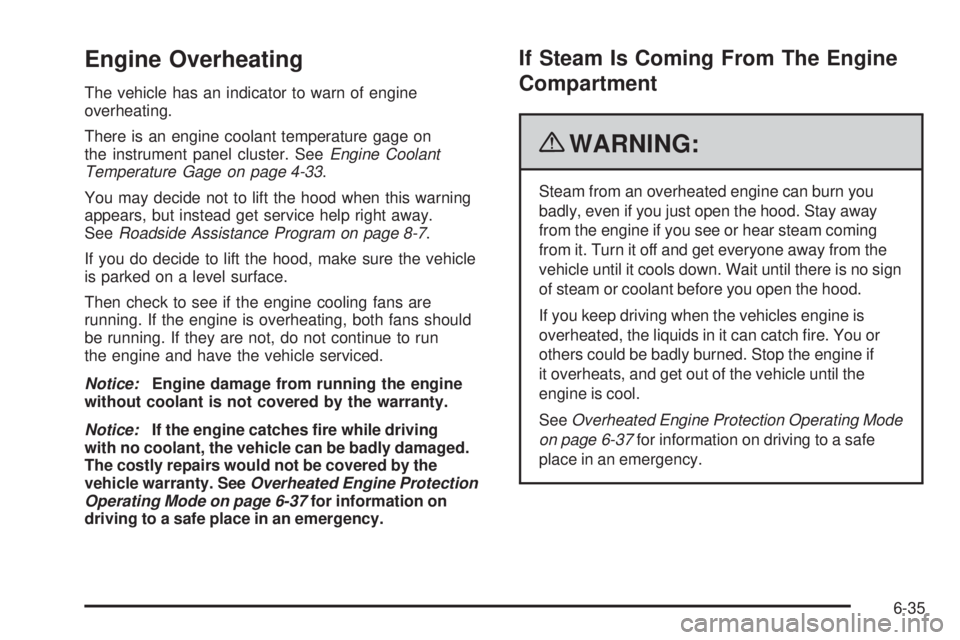
Engine Overheating
The vehicle has an indicator to warn of engine
overheating.
There is an engine coolant temperature gage on
the instrument panel cluster. SeeEngine Coolant
Temperature Gage on page 4-33.
You may decide not to lift the hood when this warning
appears, but instead get service help right away.
SeeRoadside Assistance Program on page 8-7.
If you do decide to lift the hood, make sure the vehicle
is parked on a level surface.
Then check to see if the engine cooling fans are
running. If the engine is overheating, both fans should
be running. If they are not, do not continue to run
the engine and have the vehicle serviced.
Notice:Engine damage from running the engine
without coolant is not covered by the warranty.
Notice:If the engine catches �re while driving
with no coolant, the vehicle can be badly damaged.
The costly repairs would not be covered by the
vehicle warranty. SeeOverheated Engine Protection
Operating Mode on page 6-37for information on
driving to a safe place in an emergency.
If Steam Is Coming From The Engine
Compartment
{WARNING:
Steam from an overheated engine can burn you
badly, even if you just open the hood. Stay away
from the engine if you see or hear steam coming
from it. Turn it off and get everyone away from the
vehicle until it cools down. Wait until there is no sign
of steam or coolant before you open the hood.
If you keep driving when the vehicles engine is
overheated, the liquids in it can catch fire. You or
others could be badly burned. Stop the engine if
it overheats, and get out of the vehicle until the
engine is cool.
SeeOverheated Engine Protection Operating Mode
on page 6-37for information on driving to a safe
place in an emergency.
6-35
Page 305 of 448
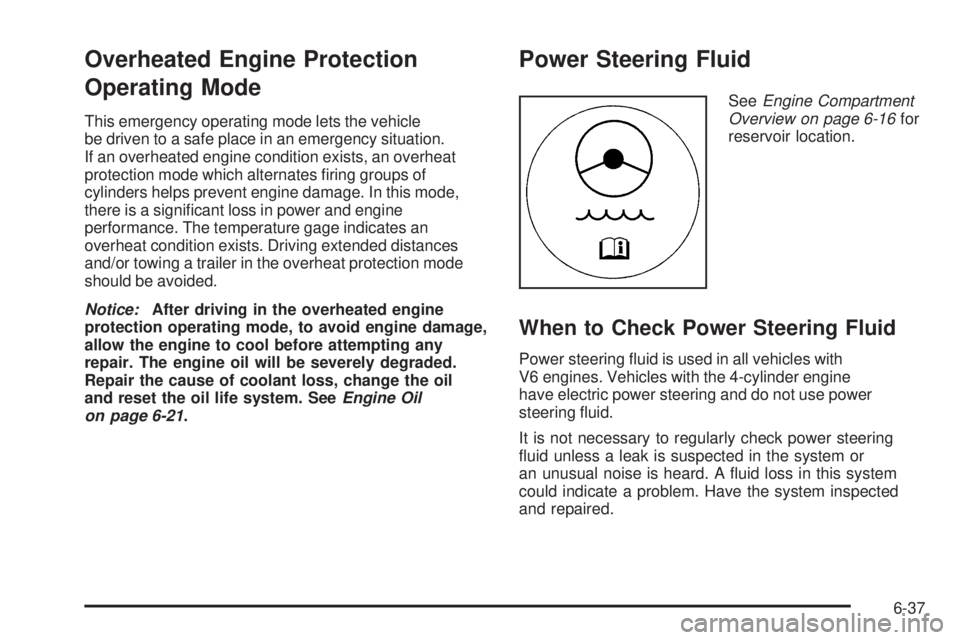
Overheated Engine Protection
Operating Mode
This emergency operating mode lets the vehicle
be driven to a safe place in an emergency situation.
If an overheated engine condition exists, an overheat
protection mode which alternates firing groups of
cylinders helps prevent engine damage. In this mode,
there is a significant loss in power and engine
performance. The temperature gage indicates an
overheat condition exists. Driving extended distances
and/or towing a trailer in the overheat protection mode
should be avoided.
Notice:After driving in the overheated engine
protection operating mode, to avoid engine damage,
allow the engine to cool before attempting any
repair. The engine oil will be severely degraded.
Repair the cause of coolant loss, change the oil
and reset the oil life system. SeeEngine Oil
on page 6-21.
Power Steering Fluid
SeeEngine Compartment
Overview on page 6-16for
reservoir location.
When to Check Power Steering Fluid
Power steering fluid is used in all vehicles with
V6 engines. Vehicles with the 4-cylinder engine
have electric power steering and do not use power
steering fluid.
It is not necessary to regularly check power steering
fluid unless a leak is suspected in the system or
an unusual noise is heard. A fluid loss in this system
could indicate a problem. Have the system inspected
and repaired.
6-37